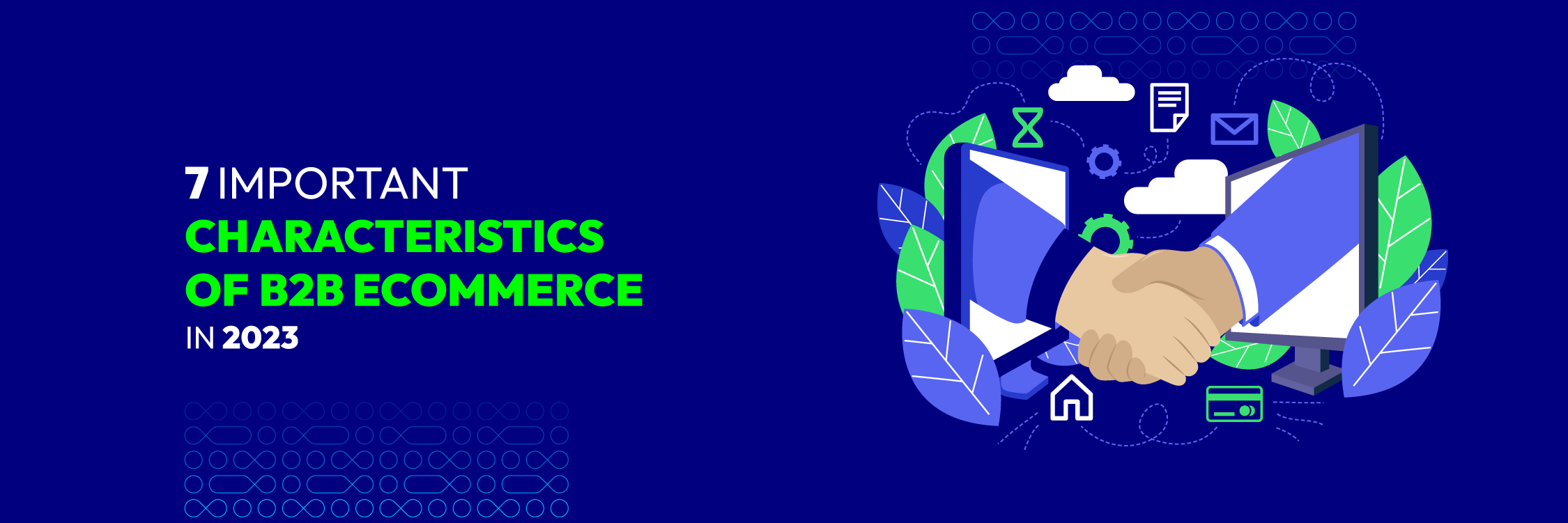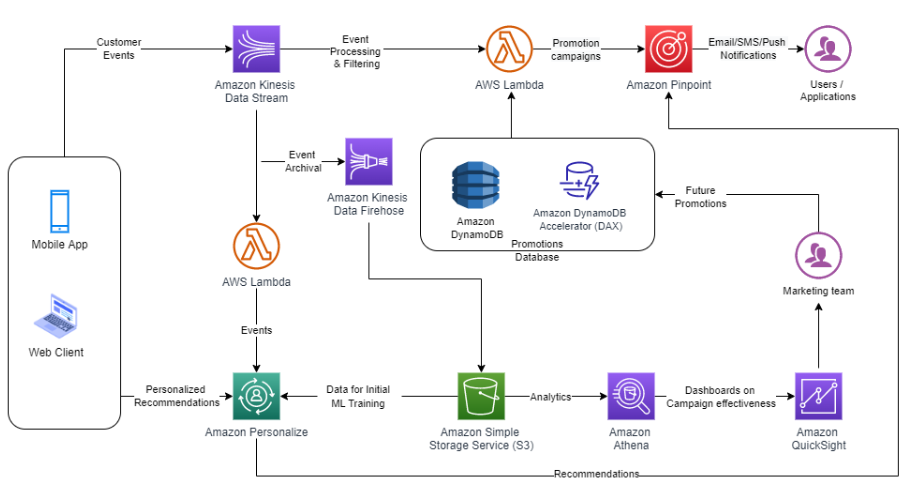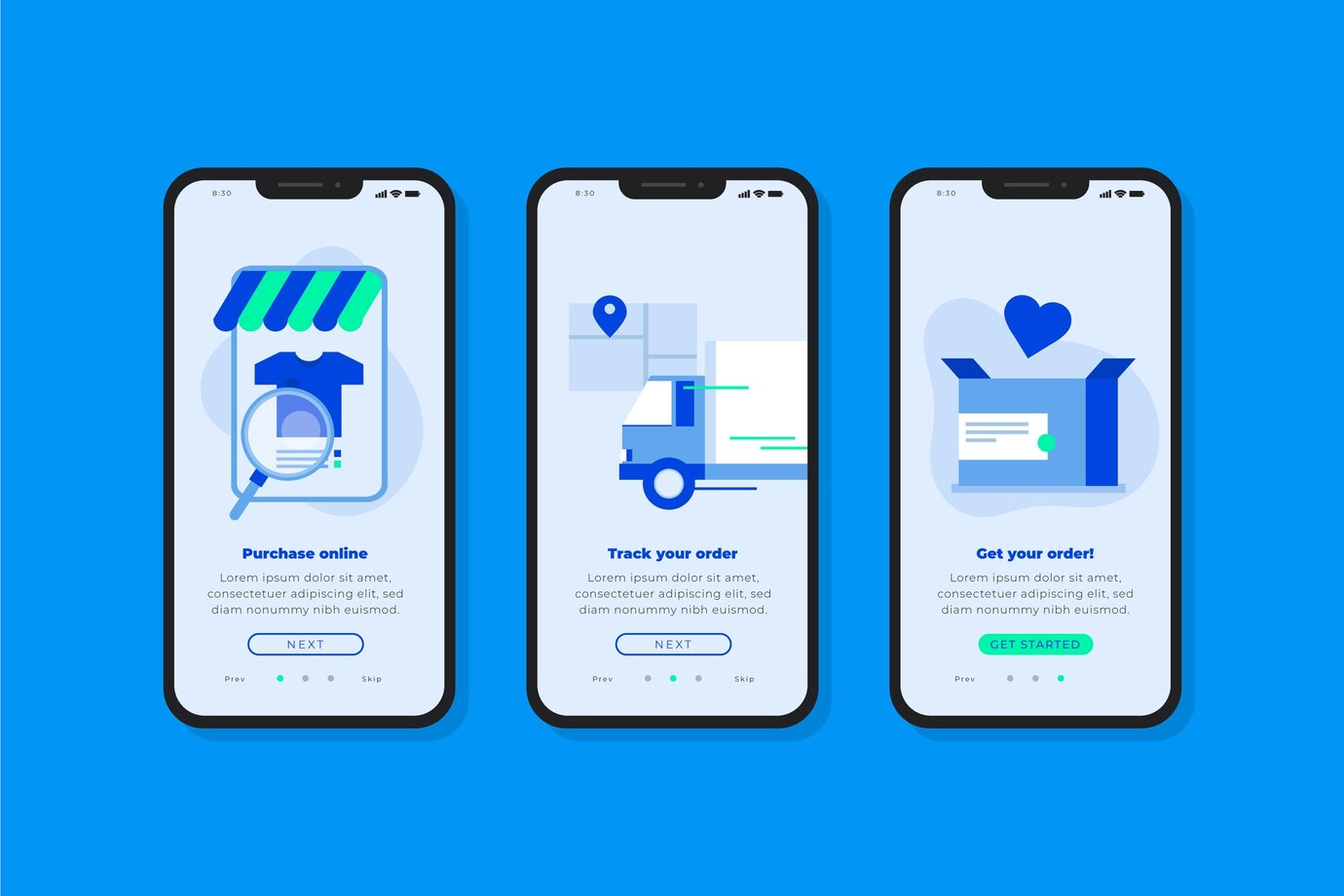9 important characteristics of B2B Ecommerce in 2025
Summer Nguyen | 03-17-2025

Nowadays, the characteristics of B2B eCommerce are undergoing notable changes in 2025. Technological advancements, changing consumer behaviors and global market dynamics are reshaping the way businesses engage and interact with each other. In this article, we will learn about the characteristics of the e-commerce in 2025, shedding light on the trends and features that are driving its transformation.
What is B2B ecommerce?
B2B ecommerce (business-to-business electronic commerce) refers to the online exchange of goods, services or information between businesses or companies. In this type of ecommerce, the transactions occur between two or more businesses rather than between a business and individual consumers (B2C ecommerce).
B2B ecommerce involves many activities, such as purchasing, selling, marketing, and servicing products or services exclusively within the business. It can include many different industries and sectors, including manufacturers, wholesalers, distributors, suppliers and service providers.

B2B ecommerce platforms and websites facilitate the exchange of products and services between businesses. These platforms often provide features tailored to the specific needs of B2B transactions, such as bulk ordering, custom pricing, negotiated contracts, and integration with business systems like ERP (Enterprise Resource Planning) and CRM (Customer Relationship Management) software.
In essence, B2B ecommerce benefits the efficiency of business transactions by leveraging digital technologies, making it easier for businesses to connect, collaborate and conduct commerce online. Whether you’re a seasoned player or new to the B2B digital landscape, try exploring B2B e-commerce solutions to unlock a world of streamlined transactions, enhanced customer experiences and increase opportunities for comprehensive development for businesses.

Discover Magento 2 B2B today and bring your wholesale business to the next level
Check it out!What are the characteristics of B2B ecommerce in 2025?
1. Personalizing Customer Experience
One of the defining characteristics of B2B ecommerce in 2024 is the emphasis on personalized customer experiences. B2B buyers now expect tailored interactions similar to their B2C counterparts. Advanced data analytics and AI technologies enable businesses to gather insights on customer preferences, purchase history, and browsing behavior. Leveraging this data, companies can deliver relevant product recommendations, targeted marketing campaigns, and personalized pricing structures. This personalization not only enhances customer satisfaction but also promotes higher conversion rates and long-term customer loyalty.
Pros
- Improved customer satisfaction: Personalized experiences directly correlate with improved satisfaction rates. By meeting specific needs, we can provide solutions that really resonate with buyers.
- Higher conversion rates: Tailored product recommendations and customized pricing structures lead to higher conversion rates. Buyers are more likely to make purchases when presented with relevant offerings.
- Brand loyalty and retention: Personalization promotes brand loyalty. When buyers feel understood and appreciated, they are more likely to return for repeat business, creating a steady revenue stream.
Cons
- Data privacy concerns: Collecting and utilizing customer data for personalization raises privacy concerns. Businesses must navigate data protection regulations while delivering personalized experiences.
- Data quality and accuracy: The success of personalization hinges on accurate data. Poor data quality can lead to misguided recommendations and alienate buyers.
Examples of Successful B2B Companies in Personalizing Customer Experience:
Amazon Business: Amazon Business employs a recommendation engine that suggests products based on a buyer’s purchase history and industry-specific needs.

Cisco Systems: Cisco utilizes predictive analytics to personalize content and product offerings for individual buyers, resulting in improved engagement and sales.
2. Tighter Access Control
Security is a paramount concern in B2B transactions. In 2025, characteristics of B2B ecommerce platforms will implement stricter access controls to ensure that only authorized individuals can access sensitive business information and complete transactions. This approach enhances data protection and minimizes the risk of unauthorized access or data breaches.
Pros
- Enhanced data security: Stricter access controls minimize the risk of unauthorized access, reducing the potential for data breaches and cyberattacks.
- Compliance and regulations: Adhering to industry-specific regulations and data protection standards becomes more manageable with effective access control measures in place.
- Mitigated insider threats: Insider threats, where employees with access misuse data, are mitigated through limited access privileges.
Cons
- User experience impact: Introducing strict access controls may lead to user frustration, especially if legitimate users face hurdles in accessing necessary information.
- Administrative complexity: Managing access levels, permissions, and user roles requires careful planning, consistent oversight, and ongoing maintenance.
Examples of Tighter Access Control in B2B e-commerce:
- SAP Commerce Cloud: SAP Commerce Cloud provides robust access controls that enable businesses to define roles, permissions, and access restrictions for users and administrators.
- Magento Commerce: Magento Commerce offers advanced user roles and permissions settings, allowing businesses to manage access to specific areas and functionalities within the platform.
3. Multichannel Integration

In 2025, B2B ecommerce will be characterized by the seamless integration of multiple sales channels into a unified customer experience. B2B buyers increasingly engage with businesses across various touchpoints, including websites, mobile apps, social media, and even voice assistants. To meet these diverse expectations, companies are adopting omnichannel strategies that ensure consistent branding, product information, and pricing across all platforms. This integration enhances convenience for customers, allowing them to transition seamlessly between online and offline channels.
Pros
- Consistent brand identity: Multichannel integration ensures a consistent brand identity and messaging, reinforcing brand recognition across diverse platforms.
- Enhanced customer experience: Buyers can seamlessly transition between different channels without experiencing disruptions or inconsistencies, leading to improved satisfaction.
- Wider reach and engagement: By embracing various touchpoints, businesses can reach a broader audience and foster higher engagement levels.
Cons
- Integration complexity: Integrating diverse online and offline channels can be technically complex and resource-intensive.
- Consistency challenge: Ensuring consistent branding, messaging, and user experience across all channels requires careful planning and execution.
Example of Successful Multichannel Integration in B2B e-commerce:
- IBM Commerce: IBM Commerce offers solutions for businesses to seamlessly integrate their online and offline channels, providing a unified experience for buyers.
- Salesforce Commerce Cloud: Salesforce Commerce Cloud empowers businesses to create personalized, consistent experiences across all channels, enhancing buyer engagement.
4. Data-Driven Decision Making

Data has become an invaluable asset in shaping B2B eCommerce strategies in 2025. Businesses are harnessing the power of data analytics to make informed decisions about inventory management, pricing strategies, demand forecasting, and customer engagement. Advanced analytics tools provide insights into trends, customer behavior, and market fluctuations, enabling businesses to optimize their operations and stay ahead of competitors. The ability to interpret and act on data has become a critical characteristic of B2B eCommerce.
Pros
- Informed strategies: Businesses gain insights into market trends, customer preferences, and product demand, enabling them to tailor strategies for maximum impact.
- Optimized inventory management: Data-driven insights aid in predicting demand patterns, ensuring optimal stock levels, and minimizing overstock or stockouts.
- Enhanced customer experience: By analyzing customer behavior, businesses can provide personalized experiences that resonate with buyers.
Cons
- Data quality and accuracy: The effectiveness of data-driven decisions hinges on the accuracy and quality of the data being used.
- Analytical skill gap: Businesses must overcome the challenge of having skilled professionals who can effectively analyze and interpret data.
Examples of Successful B2B Enterprises in Data-Driven Decision Making:
- Alibaba.com: Alibaba.com employs data-driven insights to provide businesses with recommendations and insights into global market trends and buyer behavior.
- Shopify Plus: Shopify Plus offers analytics and reporting features that help businesses understand customer behavior and identify growth opportunities.
5. Advanced payment method
We acknowledge that B2B ordering processes tend to be more intricate than those for B2Cs. Hence, the shopping cart model is the most suitable. Your e-commerce web design firm should focus on simplifying the payment process and reducing cart abandonment.
The payment procedure should not only be streamlined but also address other factors such as:
- Enabling customers to transfer shipping costs to their delivery partners’ accounts (e.g., FedEx, UPS).
- Allowing customers to retrieve payment details from previous orders.
- Providing multiple payment options like credit lines, purchase orders, commercial credit, etc.
- Facilitating the reordering of previously placed orders without the need to search for individual products again.
Pros:
-
Cash Flow Management: Advanced payments help businesses manage their cash flow more effectively by receiving funds upfront, reducing the risk of late or non-payments.
-
Reduced Risk: Since payments are received before goods or services are provided, there is a lower risk associated with non-payment or default by the buyer.
-
Improved Working Capital: Advanced payments can improve a company’s working capital position, providing funds that can be reinvested into the business or used to finance growth initiatives.
-
Streamlined Processes: Advanced payment systems often involve automated processes, leading to faster order processing and reduced administrative overhead.
Cons:
-
Customer Resistance: Some buyers may be hesitant to make advanced payments, especially for large orders, due to concerns about cash flow or the risk of non-delivery.
-
Competitive Disadvantage: Businesses that require advanced payments may lose customers to competitors offering more flexible payment terms.
-
Cash Flow Impact: While advanced payments improve the seller’s cash flow, they can negatively impact the buyer’s cash flow, particularly if the buyer is required to make large upfront payments.
6. Enhanced security and trust

B2B buyers are seeking greater control and autonomy over their purchasing processes. Self-Service Options cater to this demand by providing buyers with the tools and capabilities to initiate, manage, and track their transactions without extensive manual intervention.
Pros
- Efficiency: Self-service options streamline the purchasing process, reducing the need for manual interventions and expediting order placement.
- 24/7 Availability: Buyers can engage with the platform and make transactions at their convenience, irrespective of business hours.
- Reduced dependency: Self-service options decrease the reliance on customer support for routine tasks, freeing up resources for more complex inquiries.
Cons
- Learning curve: Introducing self-service options may require buyers to adapt to new processes and functionalities, potentially leading to a learning curve.
- Personal interaction: The shift towards self-service might reduce personal interaction with buyers, which can impact relationship-building efforts.
Examples of Successful B2B ecommerce Self-Service Options:
- Walmart Marketplace: Walmart Marketplace offers sellers self-service options to manage their online stores, including product listings, inventory management, and order fulfillment.
- Alibaba.com: Alibaba.com provides a self-service platform for B2B buyers, enabling them to search for suppliers, request quotes, and negotiate deals independently.
8. Mobile Experience Improvement
Many B2B customers are searching for professional products using their mobile devices. As highlighted earlier, nearly 94% confirm they initiate searches for business services or products on their smartphones. This underscores the significance of mobile-friendly websites, which are no longer merely an optional feature but essential for delivering optimal user experiences to your customers.

Pros:
-
Increased Accessibility: Enhancing the mobile experience makes your B2B e-commerce platform more accessible to a larger audience.
-
Competitive Advantage: Offering a superior mobile experience can differentiate your brand from others and accordingly attract more customers who prioritize convenience and efficiency.
-
Expanded Market Reach: With the growing trend of mobile usage, optimizing your B2B e-commerce platform for mobile devices allows you to tap into new markets and reach potential customers who prefer mobile shopping.
-
Enhanced Brand Perception: Investing in mobile optimization demonstrates your commitment to customer convenience and modern technology, enhancing your brand’s reputation and credibility.
Cons:
-
Costs and Resources: Improving the mobile experience requires investment in design, development, and ongoing maintenance, which can be significant for smaller B2B businesses with limited budgets and resources.
-
Compatibility Issues: Ensuring compatibility across various mobile devices, operating systems, and screen sizes can be difficult and may lead to inconsistencies in user experience.
-
User Resistance: Despite the increasing prevalence of mobile commerce, some B2B buyers may still prefer traditional desktops or have concerns about the usability and reliability of mobile platforms for complex transactions.
9. Potential Global Market

The digital landscape has made it easier for businesses to engage in global trade. In 2025, B2B eCommerce will embrace the potential of a broader international market. With fewer geographical barriers and improved logistics, businesses can explore new markets, establish international partnerships, and tap into a more extensive customer base.
Pros
- Market expansion: Entering global markets opens up new revenue streams and opportunities for growth beyond domestic borders.
- Diversification: Relying solely on a local market can expose businesses to economic fluctuations. A global presence diversifies risk across different regions.
- Access to niche markets: Businesses can identify and serve niche markets with specialized needs that might not be present in their home region.
Cons
- Cultural nuances: Entering new markets requires an understanding of cultural differences, language, and business customs.
- Regulatory complexity: Navigating international regulations, trade agreements and tax implications can be complex and time-consuming.
Examples of Potential Global Market Connections in B2B e-commerce:
- Alibaba.com: Alibaba.com connects businesses from around the world, allowing them to tap into a global B2B marketplace to find suppliers, manufacturers, and buyers.
- Shopify Plus: Shopify Plus offers businesses tools to create multi-currency storefronts, enabling them to expand into new markets with localized experiences.
Conclusion
In 2025, the characteristics of B2B eCommerce will evolve to align with changing market dynamics and technological advancements. Personalizing Customer Experience, Tighter Access Control, Multichannel Integration, Data-driven decision-making, Enhanced Security and Trust, Self-Service Options and Potential Global Market are key attributes that define the B2B eCommerce landscape this year. Businesses that embrace these characteristics are well-positioned to succeed in a competitive digital marketplace, catering to the needs and preferences of modern B2B buyers.







